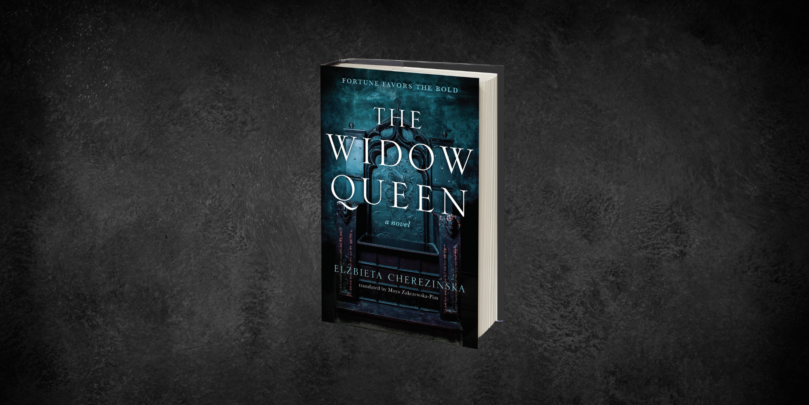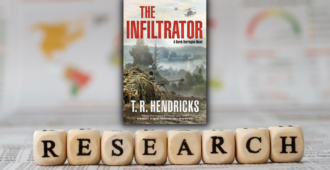 The Widow Queen by Elżbieta Cherezińska is the epic story of Świętosława, and a vividly-imagined story of an incredible queen whose life and name were all but forgotten—until now.
The Widow Queen by Elżbieta Cherezińska is the epic story of Świętosława, and a vividly-imagined story of an incredible queen whose life and name were all but forgotten—until now.
Elżbieta has joined us on the blog today to dive into the stories and history that inspired her novel, and power that rumors have in shaping our perception of history. Read her thoughts below, and grab your copy of The Widow Queen today!
By Elżbieta Cherezińska
Picture the north of Iceland in the grip of winter. The sun shines for barely a few hours a day. Gusts of wind viciously rip through the air. Leaden clouds shed flakes of sticky snow which freeze into an icy crust as soon as the weak winter sun sets. On nights that are calm and clear the sky blooms with the breathtaking northern lights. The long night knows how to dazzle.
The medieval Benedictine abbey in Iceland’s Thingeyrar did not look like what one might imagine when asked to picture a refined church building. Its ruins have failed the test of time for one simple reason: it had not been built from wood or stone, much less brick. Like most houses in Iceland, it had been made from peat. The low, long, and squat constructions with grass-covered roofs evoke the hobbit holes from Tolkein’s Middle-earth. They had no windows, so the only light in summer came in through smoke holes and open doors. In winter, it emanated from the long hearths which ran across the middle of the floors, and from smoky tallow lamps.
Let’s look at what was happening in the world nine hundred years ago: in distant and sunny Italy, the redbearded Emperor Frederick fights the Pope for power in Europe; the Crusaders have long since taken Jerusalem; the Templars guard the tomb of the Lord. Meanwhile, in the abbey in Thingeyrar, in the far north, the monks are hard at work. Following monastic practice, the day begins before dawn (even if dawn never breaks). Prayers and work. The young novices clean the fireplaces which have burned out during the night. They carry out the yellow ash that peat leaves behind when it burns. In this land where trees are scarce, peat is the fuel of choice. They carry buckets full of water next door, to the kitchen. They start a fire. The brother responsible for the kitchen brings out some dried fish and the remnants of a goat’s cheese from the pantry. Since conversation is forbidden, the meal is consumed in silence. The monks, however, have created a sign language of gestures and blinks that allows them to communicate without making a sound. The wind which howls outside the hut may be the only noise to be heard in the small refectory, but anyone who has eyes can see that emotions are about to boil over all around the table.
We know the names of only a few monks who were in Thingeyrar in the twelfth century: Abbot Karl Jonsson, Gunnlaug Leifsson and Oddr Snorrason. The last of these is my favourite, and his is the story I wish to share. He and Gunnlaug were the ones who had the most to say to one another. They were both writing sagas about Olav Tryggvason. They wrote in Latin by flickering candlelight and with watering eyes – courtesy of the smoke emitted by tallow candles. The Benedictine rule, ora et labora, pray and work, left no room for laziness. Between the Liturgy of the Hours, in the time that was dedicated to work, Oddr would stand at his pulpit and write. His monastic calling had been tested more than once over the years before he began working on the saga. One day he had had enough, and he decided to leave the abbey. He walked into the small chapel to say his farewell prayers, and found instead the dead Viking king, Olav Tryggvason. Olav spoke to him: I suffered for you, so I think you might want to suffer for me, too. Oddr went back to work, and Olav Tryggvason’s Saga was created. (Odrr, if you saw Olav the way I saw him – young, blond and incredibly sexy – then I can’t blame you in the least for choosing to stay). Odrr wrote the Saga because he wanted his beloved king to be made a saint, and it bothered him that this had not happened in the immediate aftermath of the king’s death. Considering existing traditions, it should have. In the Middle Ages, a ruler who had christened his country was almost always made a saint, like Charlemagne, or Knyaz Vladimir the Great in Russia. Only two rulers were exceptions to this unwritten rule: the Polish Mieszko and the Norwegian Olav (the one whom Odrr saw in the chapel). You will encounter them both in The Widow Queen.
The passionate Odrr believed that if he wrote down the story of Olav’s life, the world would recognize the late king’s greatness, the eyes of the Church Fathers would view his achievements kindly, and Olav Tryggvason would be proclaimed a saint. Odrr’s passion for his research, however, made him go too far. He wrote down everything he discovered, recording all the stories which circulated Iceland. He thus revealed too much. Not for the Icelanders (his Saga was swiftly translated into Old Norse), since in their tales Olav were the same as in Snorrason’s Saga. But the rest of the world read the narrative, too, and its content ensured that beatification was out of the question.
Who is Olav Tryggvason in Snorrason’s saga? He is Superman. If he walks into battle, he emerges victorious. If he builds a ship, it is the largest ship to ever have been built (you will encounter Long Snake in the second volume, The Last Crown). He can throw entire handfuls of javelins at a time (with both hands), and he catches speeding arrows in mid-flight. He climbs inaccessible mountains to rescue his less agile companions. No warrior or sailor is his equal. He is a champion swimmer, and he can take off his chainmail underwater. He uses his silver tongue to subdue rulers and seduce women. He shows no mercy when he decides to Christen Norway. His subjects are given a choice – baptism or death. The wily heathen demons stand no chance against him. If they create deadly underwater vortexes, Olav settles the waves. If they change their form, he catches them anyway. While the first section of Olav Tryggvason’s Saga is a correctly composed chronicle, it is the second part, which tells of Olav’s adventures in the far north, that is my personal favourite. With the swift change of setting, situation and character, it resembles a video reel, as if Oddr wrote down everything that Olav might have seen or heard. If Odrr filtered the stories from Iceland at all, then I cannot imagine what the tales sounded like in their original form!
Why did the memory of the Norwegian king remain so vivid in Iceland? Because he was the one who brought Christianity to the island in the year 1000. This was also the reason for which the Icelandic monk Odrr considered himself an heir to Olav’s legacy. Olav Tryggvason spent five bloodthirsty years introducing Christianity to Norway. He destroyed statues of Odin and Thor and burned their temples. He killed the jarls who refused baptism. Olav subjected his most obstinate jarls to the so-called “trial by serpent”, which involved a hollow horn with holes at both ends, one of which was placed in the victim’s mouth while a snake was placed into the horn at the other end. Olav then set fire to the horn, thus forcing the serpent to seek an escape route, and the only way out led through the back of the unfortunate Viking’s throat.
News of Olav’s exploits reached Iceland before he himself did. In the long nights spent by smoky peatfires, people fearfully exchanged tales of the Norwegian king. By the time Olav sent messengers to the island to announce that he wanted to bring Christianity to them, they knew what to expect. They held an assembly, a council of free people. They debated and had countless disagreements, because really, who wanted to replace the mighty Thor with the weak Christ? Could the Virgin Mary take the place of sexy Freya? Common sense, however, eventually prevailed, and the assembly accepted Olav Tryggvason’s offer. That is how Iceland became known throughout Europe for being the only country which accepted Christianity as a result of a democratic vote. The Icelanders proved themselves to be the exception to the rule that governs human history – they were able to learn from the mistakes of others. And, as often happens in negotiations, because they accepted the offer instead of resisting, they walked away from the table with more favourable terms for themselves (as well as a few other things that are usually only found in the small print at the end of the contract). The king allowed them to continue eating horsemeat and leaving offerings for the old gods, so long as this was done in secret, with no witnesses, and only in private homes. They also continued to leave their unwanted children to die out in the wilderness (a cruel tradition which continued for a long time, despite the Church’s best efforts to abolish it).
Many of the tales about Olav which Odrr recorded have been confirmed by other sources. I used many of these in the writing of my novel. The Battle of Svolder (also known as the battle of the three kings at Øresund), in all its detail and precision, was particularly important. For me, however, the most significant part of the saga is the the rumour according to which the battle of Øresund was brought about by Sigrid Storråda’s plotting. Storråda is none other than the Polish Świętosława: our Widow Queen.
Like other medieval women, Świętosława is rarely mentioned in the chronciles. Not even her name appears. She is referred to solely by the position she occupied beside the men in her life: “Mieszko’s daughter”, “Bolesław’s sister”, “King Eric’s widow”, “King Sven’s wife” and, finally, “the mother of the kings Harald and Cnut”. Only Oddr Snorrason, the Icelandic monk who lived over a century after her death, referred to her by her second name, her Scandinavian name: Sigrid Storråda. Sigrid the Haughty. In Oddr’s account of Olav’s life, rather than giving his heart to just one person, the beautiful warrior king had many women. But, according to Snorrason, Sigrid was the one who spun the deadly web of intrigue which stretched from the King of Swedes, her son by her first husband, through her second husband the Danish king, to Sigvald, the Jarl of the famous mercenary warriors, the Jomsvikings. Sigvald also happened to be her brother-in-law, husband to the mysterious Astrid who appears in monks’ records. According to Odrr, Sigrid despised Olav because he had broken their engagement years before. The wounded pride of a dangerous woman. Those were the rumours which spread across Iceland a hundred years after the battle at Øresund had been fought.
Where is the grain of truth in this rumour? I have spent years trying to figure it out. I created complicated family trees, connecting what monk Odrr recorded with what history tells us. For Odrr, what mattered was Olav, his hero – the monk didn’t concern himself with what happened to Sigrid Storråda after Olav’s death. He didn’t know that two years after the great battle at Øresund, her victorious husband, King Sven, banished her (which was recorded by a reliable chronicler, although he provided no explanation for Sven’s actions). If, as Oddr’s account claims, it was her plotting which had led to her husband’s victory, why did he subsequently send her away? That is a question for a writer.
Was Sigrid’s wounded pride truly the reason for her plotting? Or did her husband send her away because he realized that it wasn’t hatred that had inspired her actions after all, but love?
Thank you, Odrr Snorrason, for listening to the rumours which spread across Iceland. Thank you for listening to what the sailors had to say when they visited your island, and to the stories that women exchanged in whispers and with blushing cheeks by the fires at night. My version of events could not exist without yours. We would never have learned the delightfully risqué details of Queen Sigrid, Świętosława, the Widow Queen’s, life without you first noting them. And I don’t hold it against you, monk, my collegue, that you made a demon out of Sigrid. We each of us work in the best interestes of our hero, isn’t that right? You wanted to create an image of a warrior king, a saint. Buried in your narrative I found a proud queen.
Rumours are powerful, and the most interesting ones are about the people we all know, even if we have never met them. In the past, rumours concerned rulers. Today, rulers have been replaced by politicions, stars, and celebrities. We absorb the details of their lives to reassure ourselves that the richest members of this world love, envy, anger, and suffer, just as we, the commoners, do. My old friend Odrr of Iceland intertwined fact and rumour in his saga as he wrote in surrounded by dirt and the flickering light of tallow candles. He was lucky that his parchment survived, lucky that his brothers, the monks, translated and copied his work so many times that a version of it has endured to this day.
In the modern world, rumours travel faster. A photo appears with a single click, and all it takes is some editing and a strong heading for Twitter or Instagram to share it far and wide. In the past, a rumour spread by storytellers gained flavour and colour over time, just like wine does. A rumour would grow into a story and become part of the collective memory. Humanity’s passion for storytelling is our greatest strength. Our ancestors shared tales by the fire to distribute joy, fear, warnings, or merely to entertain one another. And we, the people of the twenty-first century, are no different. We live here and now. We work in shops and corporations, we fly to the moon and tend gardens, but once we finish our work, we like to let our imaginations run wild. We like to escape on the wings of a good story, to turn into queens and Vikings, warriors and explorers, for as long as the narrative lasts. That is our power. The power of imagination.
Order Your Copy of The Widow Queen—Available Now!











